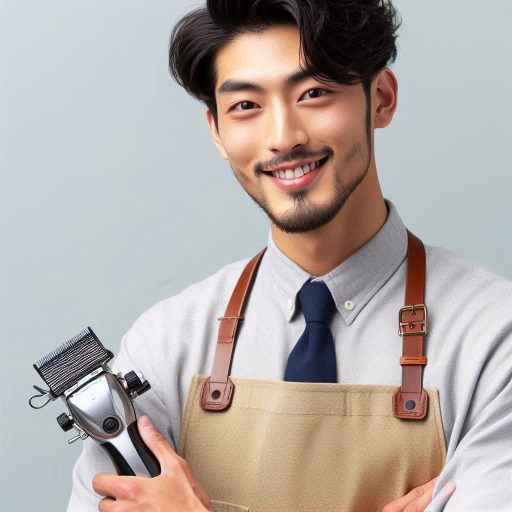Introduction
Barbers and hair stylists both play essential roles in the haircare industry.
While they both focus on cutting and styling hair, their approaches and specialties differ significantly.
Barbers typically cater to men, specializing in short hairstyles and facial hair grooming.
They often perform classic cuts, fades, and shaves, creating a clean, polished look.
Barbers are also skilled in techniques like tapering and texturizing.
In contrast, hair stylists generally serve a diverse clientele, including men, women, and children.
They focus on a wider range of hairstyles, from long layered cuts to trendy hair colors.
Hair stylists often engage in chemical treatments, such as perms and relaxers, to achieve specific looks.
They also excel in styling techniques for special occasions, like weddings or proms.
While both barbers and hair stylists work with scissors and clippers, their training and skill sets can differ.
Barbers typically undergo training in barber schools, focusing on men’s grooming techniques.
Hair stylists often attend cosmetology schools, where they learn various styling methods and treatments.
This distinction shapes their services and clientele, making each profession unique.
Understanding these differences can help clients choose the right professional for their haircare needs.
Whether seeking a traditional barber or a creative hair stylist, knowing the distinctions can enhance the overall experience.
Education and Training
Barbers
Barbers and hair stylists undergo different educational paths to develop their skills.
Barbers typically attend barber school, which focuses specifically on men’s grooming techniques.
They learn how to cut hair, shave, and create classic styles.
After completing their education, barbers must pass a licensing exam to earn a barbering license.
This credential allows them to practice in their field.
Transform Your Career Today
Unlock a personalized career strategy that drives real results. Get tailored advice and a roadmap designed just for you.
Start NowWhile both professions focus on hair, their specialties differ.
Barbers primarily focus on men’s grooming.
They excel in traditional barbering techniques, such as fades and tapers.
Barbers often create a relaxed atmosphere in their shops, catering specifically to male clients.
Hair stylists
On the other hand, hair stylists attend cosmetology school.
Their training covers a broader range of services beyond hair cutting.
Hair stylists learn about hair coloring, chemical treatments, and various styling techniques.
They study the science behind hair products and learn how to care for different hair types.
After finishing cosmetology school, hair stylists must also pass a licensing exam to earn their cosmetology license.
Hair stylists are trained to provide a wider range of hair services.
They specialize in coloring techniques like balayage and highlights.
Hair stylists also master chemical treatments such as perms and straightening.
Their education prepares them to work with diverse clients and hair types.
In summary, barbers and hair stylists follow distinct educational paths.
Barbers concentrate on men’s grooming and traditional styles, while hair stylists learn a broader range of services.
Each profession plays a unique role in the beauty industry, serving different client needs effectively.
Read: Top Haircut Trends for 2024: Barber Insights
Services Offered
When it comes to the services offered, both barbers and hair stylists have unique specialties and skills that cater to different needs and preferences.
Barbers
- Primarily focus on haircutting techniques that are tailored to men’s hairstyles.
- Expertise in beard trims to achieve precision and style for facial hair grooming.
- Specialize in traditional shaves using straight razors for a close and smooth finish.
Hair Stylists
- Offer a wide range of services beyond just haircuts, catering to both men and women.
- Skilled in various styling techniques to create versatile looks for clients.
- Provide hair coloring services to enhance or change the client’s hair color.
- Proficient in chemical treatments such as perms, relaxers, and keratin treatments.
- Additional services may include waxing for hair removal and manicures for nail care.
Overall, while barbers focus more on classic grooming services for men, hair stylists offer a diverse range of services that cater to both men and women looking to enhance their appearance.
Showcase Your Business Today
Reach thousands of readers actively exploring professional services. Publish your business profile and grow your audience now.
Publish NowRead: Continuing Education for Estheticians
Clientele
Barbers
Barbers have traditionally been associated with serving male clients, focusing on classic men’s haircuts and grooming services.
Their expertise lies in understanding men’s hair texture, facial structure, and grooming preferences.
From simple buzz cuts to intricate beard trims, barbers are skilled in offering personalized services tailored to meet the specific needs of male clientele.
Hair stylists
On the other hand, hair stylists cater to a wider range of clients, including men, women, and children.
They are trained in various cutting and styling techniques suitable for different hair types and lengths.
Whether it’s a trendy hairstyle for a young adult, a chic haircut for a woman, or a cute children’s style, hair stylists have the versatility to cater to diverse client needs.
Hair stylists may work in salons, where they have access to a wide range of styling tools, products, and equipment to meet their clients’ requirements.
Additionally, some hair stylists offer mobile services, where they can travel to clients’ homes or venues for special events like weddings, photoshoots, or fashion shows.
This flexibility allows hair stylists to provide on-the-go styling services that cater to clients’ convenience and preferences.
Overall, while barbers focus primarily on male grooming needs, hair stylists have a more diverse clientele base and offer a broader range of services that cater to different age groups, genders, and styling preferences.
Both professions play a crucial role in the beauty and grooming industry, each with its unique set of skills and expertise to serve clients effectively.
Read: Cruise Ship Staff: How to Stay Connected with Family

Work Environment
Barbers
Barbershop environments are often characterized by classic leather barber chairs, vintage decor, and a strong sense of camaraderie among barbers.
The ambiance is usually laid-back, with conversations revolving around sports, current events, and other “manly” topics.
Hair stylists
On the other hand, salons where hair stylists work can range from chic and modern to cozy and intimate.
The decor in salons is carefully curated to create a welcoming and upscale atmosphere that appeals to a diverse range of clients.
In addition to working in traditional brick-and-mortar establishments, hair stylists have the opportunity to showcase their skills in a variety of settings.
Some stylists choose to work in spas, where they provide hair treatments alongside other beauty services such as massages and facials.
Others may find employment at resorts, offering their expertise to vacationers looking to pamper themselves during their stay.
Hair stylists with a passion for fashion and editorial work may also collaborate with photographers, models, and stylists in studio settings or on-location shoots.
Ultimately, the work environment plays a significant role in shaping the overall experience for both barbers and hair stylists.
Whether it’s a cozy barbershop or a trendy salon, each setting offers unique opportunities for professionals in the grooming industry to showcase their talents and connect with clients.
Read: How to Start Your Own Esthetician Business
Tools and Equipment
Barbers
Barbers are known for using clippers, shears, and straight razors in their practice.
These tools are essential for precise haircuts, fades, and shaves that are commonly requested by their clients.
With clippers, barbers can create clean lines and achieve a uniform length throughout the hair.
Hair stylists
On the other hand, hair stylists have a diverse selection of tools at their disposal.
In addition to scissors, they also use various types of brushes, combs, and styling tools like curling irons and flat irons.
These tools allow hair stylists to create a wide range of hairstyles, from intricate updos to voluminous blowouts.
Both barbers and hair stylists must possess knowledge of different hair types and textures.
This understanding helps them recommend suitable styles and treatments for their clients.
Whether working with curly, straight, thick, or fine hair, professionals in both fields need to adapt their techniques to achieve the desired results.
Career Opportunities
When it comes to career opportunities, barbers and hair stylists both have unique paths they can take based on their interests and skills.
Let’s explore the key differences in their career options:
Barbers
Barbers can work in traditional barbershops where they specialize in men’s haircuts and grooming services.
Some barbers also choose to work in salons that offer barber services alongside other hair treatments.
Many barbers aspire to open their barbershop, allowing them to become entrepreneurs and build their brand.
Hair Stylists
Hair stylists have a broader range of career opportunities compared to barbers.
They can work in salons that cater to men and women, offering services such as haircuts, coloring, and styling.
Showcase Your Business Today
Reach thousands of readers actively exploring professional services. Publish your business profile and grow your audience now.
Publish NowHair stylists can also find work in spas, providing hair treatments to clients as part of a complete beauty experience.
Some hair stylists enter the world of editorial, working on photoshoots, fashion shows, and magazine spreads.
Others may choose to work in film and television, creating hairstyles for actors and television personalities.
Advancement and Specialization
Both professions offer opportunities for career advancement and specialization.
Barbers can focus on mastering specific techniques, such as classic men’s grooming or modern fades.
Hair stylists can specialize in various areas, including coloring, cutting, styling, and extensions.
Continuing education and training are essential for both barbers and hair stylists to stay current in their field.
Overall, both barbers and hair stylists have promising career paths with opportunities for growth, creativity, and success.
Whether you choose to be a barber or a hair stylist, passion, skill, and dedication will be the key factors in shaping your career.
Licensing and Certification
Obtaining the necessary licensing and certification is a crucial step for both barbers and hair stylists to legally practice their profession.
Let’s delve deeper into the specific requirements and differences in the licensing process for these two professions.
Barbers: Obtaining a Barbering License
Barbers must complete a designated number of training hours at a barber school approved by their state’s licensing board.
The exact number of training hours varies by state but typically ranges from 1,000 to 2,000 hours.
During this training, barbers learn various cutting techniques, shaving, sanitation practices, and customer service skills.
After completing the required training hours, barbers must pass a licensing exam that tests their knowledge of barbering techniques, sanitation practices, and state regulations.
Once they pass the exam, they can apply for their barbering license from the state licensing board.
This license allows them to legally practice barbering within that state.
Hair Stylists: Obtaining a Cosmetology License
Hair stylists, on the other hand, must obtain a cosmetology license to practice their profession.
The process of obtaining a cosmetology license is similar to that of barbers, but with a broader focus on hair styling, cutting, coloring, and chemical services.
Hair stylists are trained to work with a wider range of hair types and styles, as well as to provide additional services such as chemical treatments and hair extensions.
In addition to the training in basic hair styling techniques, hair stylists may also receive specialized training in chemical services such as perming, straightening, and coloring.
This additional training equips hair stylists with the skills needed to perform a wider range of services for their clients, expanding their earning potential and career opportunities.
Continuing Education and Staying Current with Trends
Both barbers and hair stylists are required to complete continuing education hours to maintain their licensure and stay current with industry trends and techniques.
Continuing education courses may cover new styling trends, cutting techniques, product knowledge, sanitation practices, or business management skills.
Staying current with trends in the barbering and hair styling industry is essential for professionals to attract and retain clients.
By continually updating their skills and knowledge through continuing education, barbers and hair stylists can offer the latest services and techniques to meet the evolving needs and preferences of their clients.
In a nutshell, while both barbers and hair stylists play a crucial role in helping clients look and feel their best, there are key differences in their licensing and certification requirements.
Barbers specialize in traditional grooming services such as cutting and shaving, while hair stylists have a broader focus on hair styling and coloring.
By obtaining the necessary licensing and continuing education, both professions can thrive in a competitive industry and provide exceptional services to their clients.
Conclusion
Barbers and hair stylists serve distinct roles in hair care.
Barbers specialize in cutting and styling men’s hair, focusing on short styles and facial hair.
They often provide grooming services, including shaves and beard trims.
In contrast, hair stylists cater to a broader clientele, offering a variety of services for all hair types.
They excel in cutting, coloring, and styling hair, often using advanced techniques.
Choosing the right professional depends on your specific hair care needs.
If you prefer traditional cuts and grooming, a barber may be the best fit.
If you’re looking for creative styles or color treatments, a hair stylist will likely suit your needs better.
Understanding these differences helps ensure you receive the right services for your hair type and desired look.
For those considering a career in the hair industry, both professions offer unique opportunities.
Barbers focus on a specific skill set, while hair stylists explore diverse techniques and styles.
Showcase Your Business Today
Reach thousands of readers actively exploring professional services. Publish your business profile and grow your audience now.
Publish NowExploring both professions can provide valuable insights and help you determine which path aligns with your interests and goals.
Embrace your passion for hair, and consider the rewarding possibilities that await in either field.
[E-Books for Sale]
The Big Book of 500 High-Paying Jobs in America: Unlock Your Earning Potential
$19.99 • 500 High-Paying Jobs • 330 pages
Explore 500 high-paying jobs in America and learn how to boost your career, earn more, and achieve success!
See All 500 High-Paying Jobs of this E-Book
1001 Professions Without a Degree: High-Paying American Jobs You Can Start Now
$19.99 • 1001 Professions Without a Degree • 174 pages
Discover 1001 high-paying jobs without a degree! Unlock career tips, skills, and success strategies for just $19.99!




